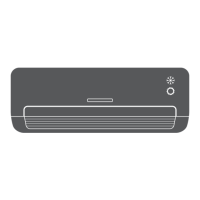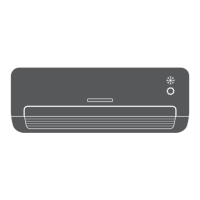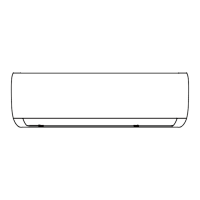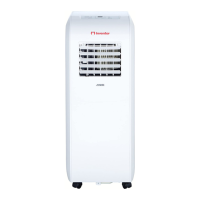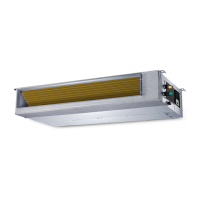Do you have a question about the INVENTOR P9VI32-09WF and is the answer not in the manual?
Essential instructions to prevent injury and property damage during operation and service.
Critical warnings regarding installation, storage, and usage to avoid fire, shock, or injury.
Safety checks for areas, procedures, ignition sources, and ventilation during servicing.
Initial safety checks and component inspections for electrical parts before maintenance.
Procedures for repairing sealed and intrinsically safe components, emphasizing safety.
Methods for detecting flammable refrigerants and leaks, avoiding ignition sources.
Procedures for removing, evacuating, and charging refrigerants safely.
Requirements for labelling de-commissioned units and safely recovering refrigerants.
Detailed dimensions and outline drawings for indoor units.
Recommended clearances and space requirements for outdoor unit installation.
Torque specifications for connections and guidelines for power cord cable selection.
Specification of pipe lengths and refrigerant amounts, plus first-time installation steps.
Procedures for adding refrigerant and collecting it before indoor unit repair.
Evacuating the system for outdoor unit repair and the refrigerant charging procedure.
Step-by-step instructions for removing the air filter and horizontal louver.
Securing the indoor unit for piping and removing the front panel assembly.
Steps to remove the chassis assembly, noting two-person requirement for 24K units.
Steps to remove the evaporator assembly, noting two-person requirement for 24K units.
Glossary of sensor abbreviations and explanation of indoor unit display icons.
Details on the unit's main protection functions against various faults.
Explanation of cooling mode, auto fan, and indoor fan running rules.
Operation rules for heating, auto-mode, and drying mode.
Details on defrosting modes and evaporator coil temperature protection.
Explanation of forced operation, sleep, auto-restart, and refrigerant leakage detection.
Description of optional modes like 8°C heating, self-clean, follow me, and silence.
How to use the remote to check operational status and error codes.
Detailed meanings and ranges for enquiry status codes.
Board function, CP remote on-off, and direct ON-OFF control setup.
Setting network addresses for controllers and understanding alarm port output.
Connection method and addressing for non-polar wired controllers.
Diagrams illustrating connections for wired and non-polar controllers.
Procedure to check temperature sensor resistance using a tester.
Measuring the resistance of each winding of the compressor.
Essential instructions to prevent injury and property damage during operation and service.
Critical warnings regarding installation, storage, and usage to avoid fire, shock, or injury.
Safety checks for areas, procedures, ignition sources, and ventilation during servicing.
Initial safety checks and component inspections for electrical parts before maintenance.
Procedures for repairing sealed and intrinsically safe components, emphasizing safety.
Methods for detecting flammable refrigerants and leaks, avoiding ignition sources.
Procedures for removing, evacuating, and charging refrigerants safely.
Requirements for labelling de-commissioned units and safely recovering refrigerants.
Detailed dimensions and outline drawings for indoor units.
Recommended clearances and space requirements for outdoor unit installation.
Torque specifications for connections and guidelines for power cord cable selection.
Specification of pipe lengths and refrigerant amounts, plus first-time installation steps.
Procedures for adding refrigerant and collecting it before indoor unit repair.
Evacuating the system for outdoor unit repair and the refrigerant charging procedure.
Step-by-step instructions for removing the air filter and horizontal louver.
Securing the indoor unit for piping and removing the front panel assembly.
Steps to remove the chassis assembly, noting two-person requirement for 24K units.
Steps to remove the evaporator assembly, noting two-person requirement for 24K units.
Glossary of sensor abbreviations and explanation of indoor unit display icons.
Details on the unit's main protection functions against various faults.
Explanation of cooling mode, auto fan, and indoor fan running rules.
Operation rules for heating, auto-mode, and drying mode.
Details on defrosting modes and evaporator coil temperature protection.
Explanation of forced operation, sleep, auto-restart, and refrigerant leakage detection.
Description of optional modes like 8°C heating, self-clean, follow me, and silence.
How to use the remote to check operational status and error codes.
Detailed meanings and ranges for enquiry status codes.
Board function, CP remote on-off, and direct ON-OFF control setup.
Setting network addresses for controllers and understanding alarm port output.
Connection method and addressing for non-polar wired controllers.
Diagrams illustrating connections for wired and non-polar controllers.
Procedure to check temperature sensor resistance using a tester.
Measuring the resistance of each winding of the compressor.
| Cooling Technology | Inverter |
|---|---|
| Cooling Power (BTU/h) | 9000 |
| Heating Power (BTU/h) | 9500 |
| Energy Class Cooling | A++ |
| Energy Class Heating | A+ |
| Wi-Fi | Yes |
| Refrigerant | R32 |
| Type | Split |
| Power Supply | 220-240V |
| Dimensions (H x W x D) | 28.5 x 80.5 x 19.4 cm |


